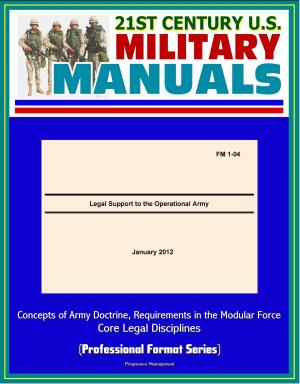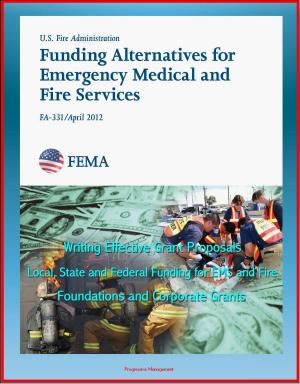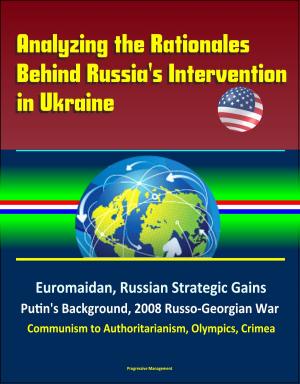Tailored Deterrence: Influencing States and Groups of Concern - Case Studies of Russia, China in the Taiwan Strait, Nuclear-armed Iran, North Korea, Triad, Hussein and Gulf War Lessons, Zero Nukes
Nonfiction, History, Military, Nuclear Warfare, Strategy| Author: | Progressive Management | ISBN: | 9781370194858 |
| Publisher: | Progressive Management | Publication: | April 2, 2017 |
| Imprint: | Smashwords Edition | Language: | English |
| Author: | Progressive Management |
| ISBN: | 9781370194858 |
| Publisher: | Progressive Management |
| Publication: | April 2, 2017 |
| Imprint: | Smashwords Edition |
| Language: | English |
This excellent report has been professionally converted for accurate flowing-text e-book format reproduction. Deterrence thinking has evolved from the Cold War to the present. During the period from 1945-1991 when the United States sought to deter attacks by the U.S.S.R. and Warsaw Pact, U.S. nuclear forces were fielded primarily to prevent nuclear war or escalation of war. However, with the breakup of the Soviet Union, as an immediate threat to the United States, and the rise of lesser nuclear states proliferating nuclear technologies, deterrence is once again reexamined for newer solutions.
During the Cold War, deterrence strategy evolved over time as officials and defense strategists thought through the changes brought by nuclear weapons. Clearly after 1945, warfare had a new component. Long-range airpower gave states an intercontinental reach. The first A-bombs had an explosive power a thousand times more powerful than an equivalent weight of high explosive bombs like TNT. When thermonuclear weapons were created half a decade later, they, in turn, were a thousand times more powerful per unit weight than the A-bombs that destroyed Hiroshima and Nagasaki. So in a period of four or five years, bomb explosive yields per unit weight increased a thousand times a thousand. This combination of long-range delivery vehicles coupled with warheads or bombs a million times more powerful than their World War II conventional counterparts led to a revolution in the way wars might be fought in the future if such weapons were employed.
Abbreviations * 1 New Thinking on Deterrence - Dr. Barry Schneider and Mr. Patrick Ellis * Part One - Deterring State and Non-State Actors: Case Studies * 2 Actor-Specific Behavioral Models of Adversaries: A Key Requirement for Tailored Deterrence - Dr. Jerrold Post * 3 Tailoring U.S. Strategic Deterrence Effects on Russia - Mr. Franklin Miller * 4 Crisis Deterrence in the Taiwan Strait - Dr. Douglas McCready * 5 Deterring a Nuclear-Armed Iran from Adventurism and Nuclear Use - Mr. Gregory F. Giles * 6 Deterring North Korea from Employment of WMD in Future Korean Conflicts and Crises - Dr. Bruce Bennett * 7 Deterrence & Saddam Hussein: Lessons from the 1990-1991 Gulf War - Dr. Barry Schneider * 8 Influencing Terrorists' Acquisition and Use of Weapons of Mass Destruction - Exploring a Possible Strategy - Dr. Lewis Dunn * Part Two - Deterrence Issues and Challenges: A Topical Approach * 9 U.S. Extended Deterrence: How Much Strategic Force Is Too Little? - Mr. David Trachtenberg * 10 Deterrence Issues in a World of Very Few or Zero Nuclear Weapons - Dr. Barry Blechman * 11 Deterrence, the Triad, and Possible Dyads - Mr. Kurt Guthe * 12 The Role of Strategic Communications in Deterrence: Lesson from History - Mr. Richard Estes * 13 A Nation's Resilience as a Deterrence Factor - Mr. Patrick D. Ellis * 14 Summary and Conclusions - Dr. Barry Schneider and Mr. Patrick Ellis
This excellent report has been professionally converted for accurate flowing-text e-book format reproduction. Deterrence thinking has evolved from the Cold War to the present. During the period from 1945-1991 when the United States sought to deter attacks by the U.S.S.R. and Warsaw Pact, U.S. nuclear forces were fielded primarily to prevent nuclear war or escalation of war. However, with the breakup of the Soviet Union, as an immediate threat to the United States, and the rise of lesser nuclear states proliferating nuclear technologies, deterrence is once again reexamined for newer solutions.
During the Cold War, deterrence strategy evolved over time as officials and defense strategists thought through the changes brought by nuclear weapons. Clearly after 1945, warfare had a new component. Long-range airpower gave states an intercontinental reach. The first A-bombs had an explosive power a thousand times more powerful than an equivalent weight of high explosive bombs like TNT. When thermonuclear weapons were created half a decade later, they, in turn, were a thousand times more powerful per unit weight than the A-bombs that destroyed Hiroshima and Nagasaki. So in a period of four or five years, bomb explosive yields per unit weight increased a thousand times a thousand. This combination of long-range delivery vehicles coupled with warheads or bombs a million times more powerful than their World War II conventional counterparts led to a revolution in the way wars might be fought in the future if such weapons were employed.
Abbreviations * 1 New Thinking on Deterrence - Dr. Barry Schneider and Mr. Patrick Ellis * Part One - Deterring State and Non-State Actors: Case Studies * 2 Actor-Specific Behavioral Models of Adversaries: A Key Requirement for Tailored Deterrence - Dr. Jerrold Post * 3 Tailoring U.S. Strategic Deterrence Effects on Russia - Mr. Franklin Miller * 4 Crisis Deterrence in the Taiwan Strait - Dr. Douglas McCready * 5 Deterring a Nuclear-Armed Iran from Adventurism and Nuclear Use - Mr. Gregory F. Giles * 6 Deterring North Korea from Employment of WMD in Future Korean Conflicts and Crises - Dr. Bruce Bennett * 7 Deterrence & Saddam Hussein: Lessons from the 1990-1991 Gulf War - Dr. Barry Schneider * 8 Influencing Terrorists' Acquisition and Use of Weapons of Mass Destruction - Exploring a Possible Strategy - Dr. Lewis Dunn * Part Two - Deterrence Issues and Challenges: A Topical Approach * 9 U.S. Extended Deterrence: How Much Strategic Force Is Too Little? - Mr. David Trachtenberg * 10 Deterrence Issues in a World of Very Few or Zero Nuclear Weapons - Dr. Barry Blechman * 11 Deterrence, the Triad, and Possible Dyads - Mr. Kurt Guthe * 12 The Role of Strategic Communications in Deterrence: Lesson from History - Mr. Richard Estes * 13 A Nation's Resilience as a Deterrence Factor - Mr. Patrick D. Ellis * 14 Summary and Conclusions - Dr. Barry Schneider and Mr. Patrick Ellis















